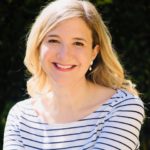My mom was diagnosed with breast cancer in 2004 when she was 50 years old. Luckily, she caught it at an early stage and after a mastectomy and hormone therapy, she’s been living cancer-free ever since.
It was scary watching my mom go through such a big health scare when I was just 23. In the following years throughout my 20s, I understood that I likely had a higher risk for breast cancer than the average person because of my family history. I knew I’d probably have to start mammograms a little earlier than my peers, but other than that, I didn’t know what else I could do — besides wait and hope for the best. I believed breast cancer was something that happened to women much older than myself, so I pushed it out of my mind, thinking I had many decades before it would ever become a real concern.
My diagnosis
Fast forward to about nine years later. I was getting ready for a big OK Cupid date. In the shower, my hand happened to graze against the side of my breast, and I felt a very distinct, hard lump that I somehow had never noticed before. In that moment, I knew. I knew exactly what it was, but I’d never expected to find it at 32 years old.
I did go on the date, but needless to say, I was a bit distracted. That week, I made an appointment to see my gynecologist – I figured he was the doctor to see, since he was the one who did my breast exams. My hands were shaking as I drove to his office, fully expecting a dramatic reaction when he felt the lump. However, I was surprised when my doctor casually dismissed my concerns, stating I was too young to be worried and that the lump was surely a cyst or something called a fibroadenoma. I wanted more reassurance than that, so I pushed for further testing, and he finally agreed to order an ultrasound just for “peace of mind.”
Since no one seemed too worried, it took almost a month to get on the schedule for an ultrasound. What was meant to be a quick morning appointment before work turned into an entire day of multiple ultrasounds, my first mammogram, and ultimately, a biopsy. A couple of nerve-wracking days of waiting later, my fears were confirmed: I had stage two invasive ductal carcinoma – breast cancer.
Upon hearing my news, my aunt ran to get a delayed mammogram she’d been putting off, and she was also diagnosed with early stage breast cancer.
My treatment
After diagnosis, I immediately faced a whirlwind of doctor appointments and life-altering decisions that needed to be made, and quickly. I hoped for kids one day, so I did two rounds of freezing my eggs, since treatment can affect fertility. I struggled with the surgery decision and whether to do a single mastectomy, double mastectomy, or lumpectomy. My genetic testing came back and since I did not have a BRCA mutation, I opted for a lumpectomy, which was followed by seven weeks of daily radiation. Because my cancer was estrogen positive, I have to be on hormone therapy for 10 years. I take a daily pill and get a monthly shot that keeps my body in menopause, because any estrogen floating around can theoretically feed lingering cancer cells. Although dealing with the side effects of menopause in my 30s has NOT been fun, I know I am fortunate to be alive.
The importance of early detection and advocating for one’s health
Early detection made a huge difference in my treatment and my survival – and my mom and my aunt’s. Even though my doctor initially brushed me off, I knew in my gut that something was wrong. I am so grateful I didn’t wait and that I spoke up, and thank goodness I did. My only regret is not noticing subtle changes in my breast more quickly. Looking back, I realized I’d had some pulling of the skin near my armpit prior to diagnosis (basically a crease that hadn’t been there before), but the change was so slow, it didn’t raise any red flags. I also had chest pain that I attributed to stress, but later realized was actually pain from the tumor. Knowing your normal is SO important so that if something does change in your body, you are able to recognize it and bring it to your doctor’s attention. If you know something’s not right but your doctor isn’t listening, never hesitate to speak up or to get another opinion.
I just hit six years as a survivor and I’m doing fine, and that’s in large part thanks to early detection. It’s one of the reasons I’m so passionate about the Rivkin Center’s mission. Not only do we want to educate women, but even more importantly, we want to provide tools for all of you to take charge of your health and to be your own advocate. It’s not all about my story, it’s about all of YOURS – and your moms, your aunts, sisters, and friends. It’s about empowering everyone to be proactive with our breast and ovarian health.
Jenny Schuster is a breast cancer survivor and Rivkin Center education program team member.
Want to help other people understand their cancer risk and advocate for their health? Share your story.


